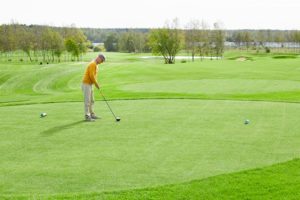Here’s some of the single plane golf swing tutorial to make your single plane swing much better and tips on How to know if your golf swing is on plane.

The golf swing plane refers to the imaginary line from the trajectory of your shoulder and left arm.
When your shoulder and left arm swing on the same line with the left arm making contact on your chest, it’s a single plane golf swing.
Moe Norman, a famous golfer that uses one-plane golf swing, has been very successful using this technique.
Single Plane Golf Swing Tutorial
Ben Hogan “swing plane” coined the phrase first in the book “Five Lessons: The Modern Fundamentals of Golf” in 1957.
Upon hitting the golf ball, the swing plane affects the flight path and path of where the ball will land.
Here, you will understand how to make sure your golf swing is on plane.
-
The course of a Single Plane Golf Swing
If the golfer starts to learn single plane golf swing, you’ll see a circle when you stand at their back or if you see through the target line.
The shot trajectory will go through the target line reasonably close. Going back, it must be the same.
Take a hula-hoop, hold it, and position the hoop’s bottom at the placement of your ball.
If you bring the hoop towards the back lined up on the golfer’s ear, it’s relatively near the single plane swing path.
Benefits of Single Plane Golf Swing
This type of swing plane has plenty of advantages, although many pros do not prefer to use it.
Usually, many golfers utilize the two plane swing path that starts the clubhead on the outside and returns from the inner side of the ball.
These may be different for beginners as the former is much easier to execute.
Below are some of the benefits of a single plane golf swing tutorial.
-
You Can Repeat It with Ease
You play golf using muscle memory. Being a consistent golfer means you need to have a repeatable and executable swing.
If you want your score to improve, you have to decrease your misses in hits.
If executed properly, moving the shoulders, hips, and arms in the single plane swing is easy. You need to bring down the club in the correct position on the downswing.
This procedure is way easier to pick up and carry out.
-
Makes a Consistent Swing
This type of swing generates a constant draw when effectively utilized.
Naturally, the shoulders and arms will end up on a similar plane, which provides a flatter and better swing while your club is angled around your body.
When you properly execute this kind of swing, you can perform a swing that allows you to slightly hit the ball from the inner target line.
Your goal is to finish with a slight draw outcome, or the recommended shot for many players.
-
Fewer Rotations
For beginners, you can consider fewer body motions as the key to success.
You will minimize the twisting motion of a two-plane swing when you choose to pursue a single plane swing.
-
Produces Top-Notch Strike
Moe Norman and Ben Hogan were famous for playing the game using a single plane swing path.
It gives many benefits and dramatically affects the success of their careers. Using this swing provides increased ball contact when correctly executed.
These will also generate other advantages, such as greater distance and precision.
Understanding Single Plane Swing
How to know if your golf swing is on plane? It’s a great idea to recognize the most suitable swing for you before you learn the single plane swing.
Here’s a single plane golf swing tutorial:
-
Address
In the single plane swing, you need to position your hand in the clubhead front, which is identical to the place of the impact.
This is the “rod” position, and both your arms and club are positioned in a single direction comparable to the impact position.
-
Backswing
On how to make sure your golf swing is on plane, you will start your backswing by shifting the club straight within the impact path.
This golf swing maintains the leading arm and shoulder correlation.
It makes it much easier for your club to execute the swing path’s follow-through towards the peak of the swing.
-
Peak of Your Swing
Your leading arm must have direct contact with your body’s shoulder curve, and the tilting of the spine shouldn’t be changed.
The primary thing that changes is how you establish a full hinge for the wrists on how to know if your golf swing is on plane.
-
Pre-Impact Motion
How to make sure your golf swing is on plane while on the pre-impact motion?
As you retain the tilt of your spine, your club head will remain at the back of the ground trail foot and the ball.
Your leading leg will stay stable and tense, and the similar plane on which your swing began must also be the parallel plane it will return to.
-
Position of the Impact
To make the ideal impact position, this type of swing must come back to a similar shaft path as your swing began with.
Drills for Single Plane Golf Swing
-
Horizontal Drill
A horizontal drill is recognized as the best practice drill of a single plane golf swing tutorial.
This swing will enable you to pinpoint the right plane and prevent you from getting bad shots.
-
- You should start to address the ball like you usually do for this drill with your seven iron.
- Stand up straight and at shoulder level, move the club outward your body.
- You would want to ensure that the clubface aligns with your target. Also, the shaft must be leveled with your trail arm.
- With your shaft and arm leveled, twist your upper torso towards the right and rotate your wrists while you’re going back, and do a complete hinge.
- To place your clubface at a square position with the swing’s target mid-point, you must twist your body to forward swing while rotating your wrist over.
- When you hit a ball, you have to hold the trailing golf club and your arm aligned through the impact location.
- You should start to address the ball like you usually do for this drill with your seven iron.
This drill lets you complete the swing toward the target in equilibrium using the body. This drill can assist you in having a sense of single plane swing if performed correctly.
-
Noodle Drill
Noodle drill is yet another excellent drill to learn single plane swing.
A noodle for the swimming pool and an alignment stick or broken shaft are necessary for this drill.
-
- Put the noodles on the shaft or stick and make sure that some noodles are sticking out.
- Position the stick and noodles on the surface within 45° angle. That will make the noodle make contact with your wrist while you are about to take a shot.
- After that, try making a swing.
- Put the noodles on the shaft or stick and make sure that some noodles are sticking out.
When you follow the steps properly, your hands should move right under the noodle when you pull the club towards the back.
If something goes wrong, the noodles will give an immediate assessment for you to execute adjustments.
Often, a single plane swing is an easier swing to master and use for amateur players.
If you wish to use or learn this swing type, you can utilize the two drills and assess if you need a single plane golf swing tutorial.
5 Steps to Perfect One-Plane Swings
Bryson DeChambeau modified his single plane swing basics using science and ideas from the book “THE GOLFING MACHINE.”
Although he struggled at first, he later discovered that the single plane swing could be perfected using golf clubs of all similar lengths. Which he effectively did.
Here is Bryson Dechambeau’s single plane golf swing tutorial.
-
Step 1: Use the Palm of Your Hand and Not the Fingers
Put the club’s grip in the center of the palm of your dominant hand, then grip it until your fingers are wrapped around the shaft.
Your grip should feel tighter and fastened. Using thicker golf grips helps to reduce issues with adapting to the grip.
-
Step 2: Begin Moving the Club Before You Start the Swing
This tip comes from “The Golfing Machine.” Before he starts his backswing, DeChambeau starts to push his hands forward and shifts his weight to his right foot.
He called it the “trigger,” which helps develop a consistent rhythm for the one-plane swing.
-
Step 3: Imagine a Circle Around Your Body and Follow That Loop
It’s ideal for your swing to follow that imaginary circle. The club, arms, and hands will follow the imaginary circle’s path.
This is an exemplary technique for visualizing and learning the proper single plane swing.
-
Step 4: At the Peak of Your Backswing Keep a Flat Hand
It’s essential at the peak of your backswing to keep a flat hand and keep the single plane swing on the path and prevent bad shots.
At the peak of your backswing, the knuckles, wrist, and arm should form a straight looking line.
-
Step 5: Twist Your Upper Torso Around a Center Location
Instead of shifting your weight from one side to another, twist your body circling the center point.
It’s super challenging to develop a reproducible one-plane swing when you’re shifting your weight at the same time with your shoulders and hips.
Proper rotation of your body is the trick for a better single plane swing. Maintain your head position while doing a swing and even after the contact.
Single Plane Golf Swing Perfection!
The one-plane or single plane golf swing is a type of swing increasing in popularity as it’s easier to execute.
It’s easier than the two plane golf swing because it uses less motion.
Every golfer has a different plane of swing. It depends on their physique, condition, and how they want to swing.
You might want to take a single plane golf swing tutorial from a golf instructor.
More Information
Last Updated on December 4, 2023 by Paul Roger Steinberg





